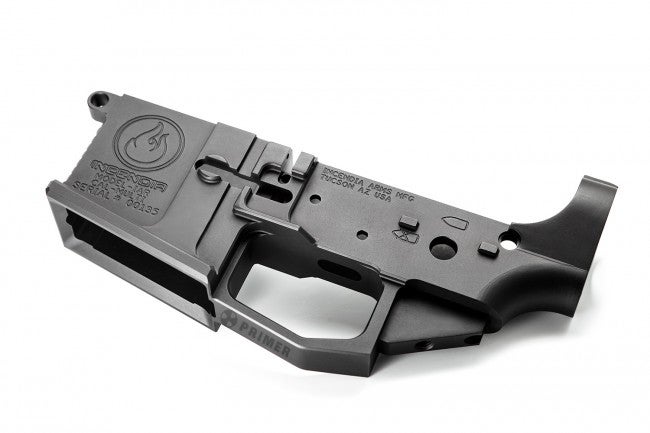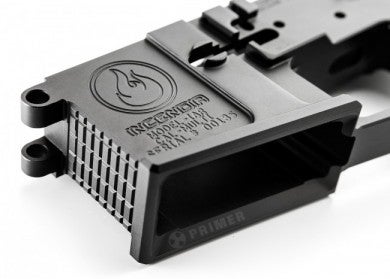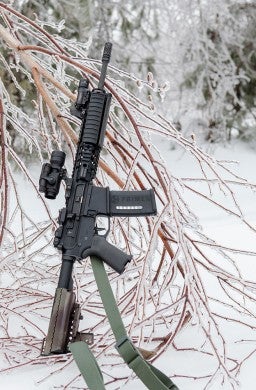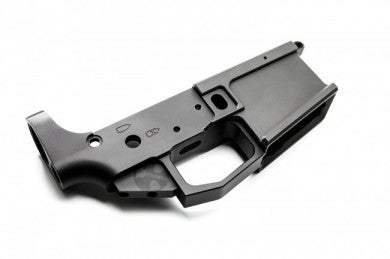Wow, another billet lower. It seems like every week a new company pops up with an AR-15 lower offering. At this point I think most of us are starting to experience lower fatigue. You are now probably wondering, why should you care about this one?
I stumbled upon Incendia Arms by chance. Over the past year I have been searching high and low for a lower to fill a gap in my collection. What I wanted was simple, a billet lower constructed of 7075 aluminum with an integrated trigger guard, that also uses a standard bolt catch and cost under $200. Sounds easy, right? Not so much. There are a few options out there, and I have tried some of them, but so far nothing had impressed me enough to keep it around. I purchased my Incendia lower in December of 2013. Right out of the box I was impressed with it; I’ve had it for two months now and I’m still just as enamored by it.
When it comes to making a quality lower the most important thing (to me) is the fit and finish. Next, it would be the attention to detail. Finally I hone in on the aesthetics (I am a professional photographer). The first thing that keeps me from purchasing most lowers is how they look. It’s something I can get hung up on and it is very unfortunate. If I cannot bring myself to buy it, I will never know if it’s any good or not. If you’re reading this then your eyes probably function. If your eyes are working, you can probably decide for yourself if you like the look of the Incendia lower or not.
Personally I think it looks great, and there are a few things I think are worth mentioning. A big deal breaker for me with most companies is when they go nuts with unnecessary designs, wonky lines, and obnoxious kitsch. Incendia makes a clean lower; the lines are very strong and give it a distinct appearance. Visually, the lower mates up well with most uppers, you can throw a traditional forged upper on one of these without it clashing; it also looks good with the new breed of squared-off billet uppers that everyone is offering these days. I know that’s a subjective statement, but the reason I believe it to be true is how Incendia does the cut around the receiver extension. With typical lowers there is a step down to match the diameter of the upper, with the Incendia they have a consistent radius front to back. The square appearance means there isn’t an unnecessary line to draw extra attention to any differences where the upper and lower meet. For example a Vltor upper has a millimeter or so of difference, but it’s hardly noticeable; even my Noveske FFL doesn’t match contours perfectly with my Vltor uppers. With standard forged uppers and most others, the transition is seamless. In my opinion the Incendia lower is visually compatible with a wider range of uppers than any of my other lowers. Incendia has it in the works to put out their own billet upper to go with their lowers. I know for sure that I will acquire one and finishing off one of my projects with it.
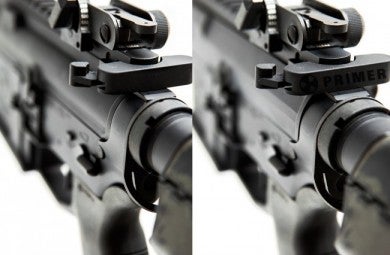
Left, the Incendia lower paired with a standard forged upper. Right, the Incendia lower paired with a Vltor MUR.
Incendia incorporates several other subtle and distinctive design characteristics throughout the lower. In front, the material around the pivot pinholes doesn’t taper down the front of the magwell the way most do. Instead they keep with the squared off theme. Maybe it was intentional, or just a lucky coincidence, but it’s a nice homage to the early M16A1 lowers. While I personally don’t care much for texturing on the front of magwells; Incendia does a nice simple grid that’s visually cohesive with the rest of the piece, and doesn’t distract or detract. Finally, I am a big fan of how the line from the bottom of the magwell flows continuously through the trigger guard until it angles back up to seamlessly meet the grip. Now let’s hit some other important stuff.
The lower’s fit and finish is excellent. They take the Milspec “window” and tighten it down to the sweet spot so you get a very precise lower that has a great snug fit. My method for determining if a lowers is a keeper or not isn’t to break out a pair of calipers and start measuring everything. I pull out every upper I own, every trigger I have available, a bunch of magazines, and start playing Legos. More often than not I’ll find some combination that doesn’t work very well. With the Incendia lower I could not find any clashes with “in-spec” known quality parts. I’ve already praised the lower for its visual compatibility with various uppers, but it also does that on a functional level as well. The ability to fit-up a wide variety of uppers is a key characteristic for those of us who are always building and configuring custom rifles. It’s important to have quality parts that interface well with each other.
One of my biggest fears with building any new lower is that the holes for the trigger pins will be off. It has only happened to me once before. The Incendia had no issues with a variety of triggers I function tested in it. Another crucial area that a surprising amount of companies could do much better on is the magwell. Too often I’ll get a lower that won’t drop a mag, or the mag catch is slightly off and you have to the slam the shit out of a mag to get it to latch. Every one of my “go-to” magazines worked perfectly. I don’t have a specific “magazine loyalty,” but I tested it with Okay, Lancers, and Pmags/Emags. Even oddballs like steel E-landers latched with no opposition and dropped free. Lastly, there is the actual finish itself. Incendia leaves no sharp edges, or machining marks anywhere on the lower, and the anodizing is a very nice dark semi-gloss black. There are several well-known, quality lowers in my stable. Mega, KAC, LWRC, Noveske, and AXTS to name a few, and except for additional features like ambidextrous bolt releases, none surpass the Incendia; this is why it is now my go-to workhorse.
Out of the box I noticed the 1/4-28 nylon tipped upper/lower tension screw. This is something that I’ve come to expect from anyone who makes a billet offering, but still some manufacturers don’t integrate it. Next I found the 4-40 setscrew to capture the rear takedown pin detent spring. If you’ve ever chased detent springs across your workshop you’ll appreciate this. While it does require clipping the takedown pin spring, it’s very handy when it comes time to remove an endplate. It’s a simple little feature, but almost no other manufacturer is doing it. Without these little bonuses the lower would still be 100% functional, but the fact that they go above and beyond is a strong indicator that they care about the product, and aren’t just jumping on the AR bandwagon to cash-in.
My only disappointment was that I had hoped the lower would have a setscrew in place of the roll pin for the bolt catch. The company told me that the implementation of a setscrew in place of a roll pin is an improvement they are working on. They are also thinking about giving users the option of where to install the rear takedown pin detent and spring, either in the traditional location out the back, or under the grip like KAC does. In the near future we may see several more iterative improvements. One possible improvement is the integration of the PDQ ambidextrous bolt catch from Teal Blue Bravo.
Unfortunately all of this good comes with a little dose of reality. Incendia lowers won’t always be as affordable as they are now. I purchased mine for $125, and you can imagine that my expectations weren’t all that high. When I got it, and realized how good the product was I sent of an email to one of the owners, basically asking how they are even keeping the lights on at their shop? He very clearly explained to me that they are just trying to get their name out into the industry, and get lowers into people’s hands as quickly as possible. They fully admitted that their product is worth more than they were charging. However, one of their goals is to always deliver the best product at the best possible price; their parts will always be affordable. Right now they are selling a lower for well under $200 that’s on par or better than some $300 lowers I’ve had. If you are not concerned with feature creep or pizazz, I’d argue that Incendia makes one of the best lowers, period. And as long as they stay under the $200 mark you’ll be hard-pressed to find a better value. Anywhere.
– Primer
 Your Privacy Choices
Your Privacy Choices
